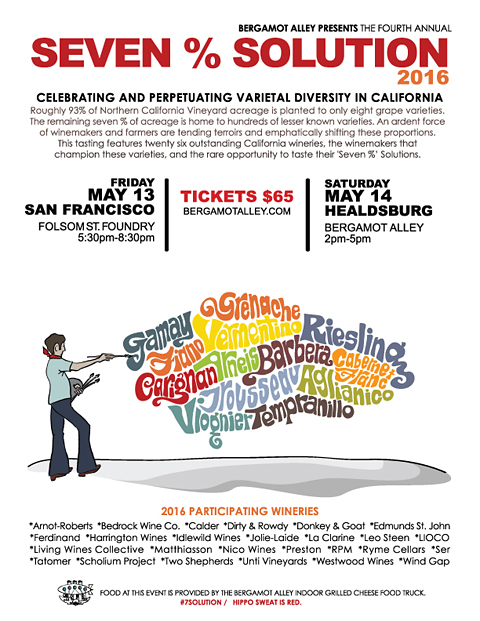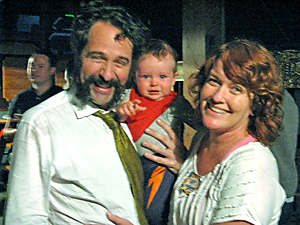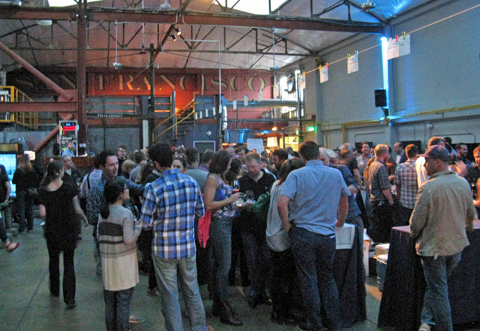Arnot-Roberts
The winery was founded by Duncan Arnot Meyers and Nathan Roberts in 2002. While they continue to make varieties such as Chardonnay, Pinot Noir, Cabernet Sauvignon, and Syrah, they’ve also become known in recent years for wines from lesser-known California grapes. Both Duncan and Nathan were behind the table for the event, and they poured three wines for me – 2014 Ribolla Gialla, 2014 “Old Vine White Wine,” and 2014 North Coast Trousseau. The Ribolla was from Napa Valley’s Vare Vineyard, fermented in stainless steel with some of the juice being direct press and some kept on the skins before pressing, then aged in neutral oak. Light yet with a slightly creamy texture, this featured pear and stone fruit on the nose. The “Old Vine White Wine,” from Heinstein (formerly Compagni-Portis) Vineyard in Sonoma Valley, is a field blend from mostly Gewürztraminer and Sylvaner, along with several other varieties – this was a standout, with aromas of citrus and pear fruit plus exotic spices, bright acidity on the palate, and a clean finish. The Trousseau, sourced from three vineyards, had spice and herbal notes along with red fruit, plus touches of flowers and pepper, and a bigger structure than previous vintages, finishing with chalky tannins. All three of these wines should benefit from more bottle age.
Bedrock Wine Co.
 |
Bedrock’s Morgan Twain-Peterson is the son of Ravenswood winery founder Joel Peterson, and he launched the label in 2007. Chris Cottrell joined Morgan as a partner in Bedrock in 2012, and he was on hand to pour the wines. Morgan and Bedrock have brought much attention to the preservation of old vines in California. Chris poured me four Bedrock wines at the tasting – 2015 “Ode to Lulu” Rosé, 2014 Compagni-Portis “Heritage White” (Gewürztraminer, Trousseau Gris, Roter Veltliner, Chardonnay, Riesling field blend), 2014 Evangelho “Heritage” (Carignan, Mourvèdre, Zinfandel, Alicante Bouschet, Mission, Palomino field blend), and 2014 Nervo “Heritage” (field blend of over a dozen varieties). The “Ode to Lulu” – mostly whole-cluster pressed Mourvèdre along with Carignan and Grenache – is often a favorite and this year was a return to form for this fine Rosé, displaying bright and fresh strawberry, orangepeel, and floral scents and zippy acidity. The “Heritage White” was another winner – this was made with half the fruit spending about 12 hours on the skins prior to pressing. With spicy Gewürz aromas but toned-down floral notes and an earthy phenolic component, plus a slightly chalky texture, this was a fascinating young white that should develop further with some time in the bottle. The Evangelho “Heritage” wine – sourced from a noted site in Contra Costa County with own-rooted old vines planted in deep sandy soil – showed plum, earth, pepper, spice, and a stony mineral note on the nose, plus a lively mouthfeel and finish, quite tasty. The Nervo “Heritage” fruit came from Alexander Valley, and showed a darker profile with less upfront fruit and more earth, smoke, and spice components, plus a bigger structure and grippier finish. Very nice showing for the Bedrock wines – one of the strongest line-ups at this year’s tasting.
Calder Wine Company
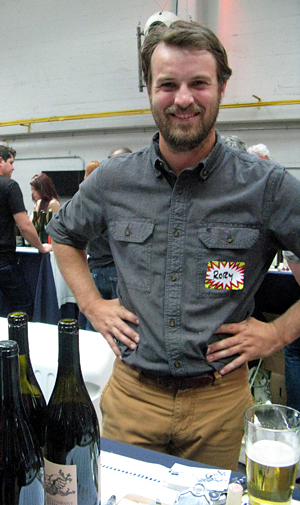 |
Rory Williams (Calder is his middle name) established his label in 2011. He grew up around wine – his family owns Frog’s Leap Winery in Napa Valley, and Rory sources some of his fruit from their vineyards. Calder has focused on traditional but somewhat overlooked California grape varieties. Rory was behind his winery table at the tasting, and poured me six of his wines – 2015 Dry Riesling, 2015 Chenin Blanc (pre-release), 2015 Carignane Rosé, 2013 Charbono, 2014 Carignane, and 2013 Petite Sirah. The Riesling, Chenin Blanc, and Charbono all came from Napa Valley vineyard sources that Frog’s Leap farms. The Riesling was a standout – kept on the skins for about three hours before pressing, and made in both stainless steel and neutral oak, this had bright citrus aromas with earthy, floral, and herbal notes, and a slightly chalky texture on the palate and finish, quite distinctive. The Chenin displayed pear and stone fruit on the nose along with a stony mineral quality, a lively yet smooth mouthfeel and slightly tangy finish – this could use a bit of time to settle down but showed fine potential. The two Carignane wines were sourced from old vines in Mendocino County, mostly in Redwood Valley. The direct-press Rosé was on the lees for six months, and showed plum and spice notes with medium acidity, while the 2014 Carignane had riper plum and berry fruit with a firm tannic finish. The Charbono and Petite Sirah were my favorites of the Calder reds – the Charbono was very true to the variety, with earth, plum, pepper, and leather on the nose, medium weight with moderate tannins. The Petite Sirah (fermented with 100% whole clusters) had darker fruit plus earthy, stemmy, and floral notes, full-bodied with plenty of structure for aging. I’d missed Calder at last year’s tasting, and their whites in particular this year were highlights.
Dirty and Rowdy Family Winery
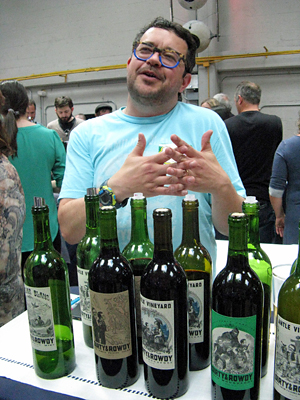 |
Established in 2012, Dirty and Rowdy is the project of Hardy Wallace and Matt Richardson with their wives Kate and Amy. The winery is one of the few in California specializing in Mourvèdre, with a number of single-vineyard bottlings from various parts of the state. All of the red wines are fermented entirely with whole clusters. As usual, Hardy was behind the table at the tasting, and he poured six wines for me – 2015 “Familiar Blanc” (Chenin Blanc, Pinot Blanc, Chardonnay, Melon, Roussanne, Viognier), 2014 Antle Vineyard “Skin-fermented” Melon, 2015 “Familiar” Mourvèdre, 2014 Antle Vineyard Mourvèdre, 2014 Skinner White Oak Flats Vineyard Mourvèdre, and 2014 Fred & Dora’s Vineyard “Old Vines” Petite Sirah. The “Familiar Blanc” came from a variety of sources, with mostly direct-to-press fruit along with some that was skin-fermented – this had subtle stone fruit, earth, and herb notes with a slightly phenolic character from the skin contact. The Melon, which underwent a 40-day maceration, featured more intense phenolic character with plenty of herbal notes, a touch of citrus zest, and the fruit playing a supporting role – this had a deeper color and an interesting chalky texture. The “Familiar” Mourvèdre, sourced from about six vineyards, displayed bright, spicy, herbal/stemmy, and earthy red fruit, with a lively texture and moderate tannins – a fine Mourvèdre to drink now. Next were a couple of more “serious” Mourvèdres. The Antle Vineyard bottling showed bolder and darker fruit with lots of earth and spice, plus a chalky tannic finish, while the Skinner White Oak Flats bottling featured plummy fruit, earth, and herbs, with a strong stony mineral element and a firm tannic finish – both a bit young right now but showing great promise for cellaring. The dark, herbal, peppery, and very grippy Petite Sirah, from a vineyard near Ukiah, finished things up. Nice wines across the board, with the two single-vineyard Mourvèdres being the stars of this line-up.
Donkey and Goat Winery
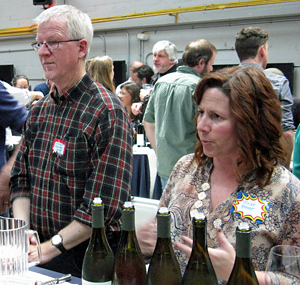 |
| Steve Edmunds (Edmunds St. John), and Tracy Brandt (Donkey and Goat) |
The idea for Donkey and Goat began when husband and wife team Jared and Tracey Brandt left their jobs in 2001 and traveled to France to learn winemaking from noted vintner Éric Texier. They now make their wines in Berkeley. Tracey was on hand for the afternoon tasting and Jared took over in the evening. I tried five Donkey and Goat wines – 2015 Grenache Noir, 2015 “The Gadabout” (Picpoul, Grenache Blanc, Roussanne, Marsanne, Vermentino), 2015 “Blanca” Pinot Gris, 2015 “Ramato” Pinot Gris, and 2014 “Stone Crusher” Roussanne. Sourced from three vineyards in El Dorado County and aged in neutral oak, the Grenache showed higher-toned red fruit and spice on the nose, with a lively mouthfeel and fairly big, chalky tannins. “The Gadabout” is a wine made for restaurant by-the-glass programs, and featured more upfront fruit than the other Donkey and Goat bottlings, with pear and apple notes along with savory herbal undertones and a bright texture. The fruit for the two Pinot Gris wines came from Filigreen Farm in Anderson Valley. The “Blanca” was my favorite – pressed after five hours on the skins and aged in neutral oak, this had a very savory character along with lots of spice and stone fruit aromas, a moderately creamy mouthfeel and clean finish. The fruit for the “Ramato” spent five days on the skins and was made in concrete – this had a cloudier appearance, more earthy aromas and less fruit, finishing with noticeable tannins. The “Stone Crusher” Roussanne, sourced from El Dorado fruit, was skin-fermented for 15 days and aged mostly in neutral oak – displaying stone fruit, citrus zest, and earth with a chalky character, I preferred this to the “Ramato” Pinot Gris. Donkey and Goat always features an intriguing group of wines, and these five were no exception.
Edmunds St. John
Started in 1985 by Steve Edmunds and his wife Cornelia St. John, the winery has moved a few times over the years. The production is split between the Perry Creek facility in El Dorado County (where Steve sources most of his fruit) and a small facility shared with a few other producers in West Berkeley – fittingly, it’s the same spot where he started 30 years ago! Steve focuses mainly on Rhône varieties and blends, along with Gamay Noir. Steve also makes Cabernet Franc for the Bebame label, in which he partners with Don Heistuman and noted El Dorado grower Ron Mansfield. Steve poured four Edmunds St. John wines at the tasting – 2015 “Heart of Gold” (53% Vermentino, 47% Grenache Blanc), 2015 “Bone-Jolly” Rosé (Gamay Noir), 2014 “Bone-Jolly” Gamay Noir, and 2014 “Rocks & Gravel” (43% Grenache, 43% Mourvèdre, 14% Syrah). The fruit for “Heart of Gold” comes from Fenaughty Vineyard in the Apple Hill area near Placerville, and the wine showed bright pear and stone fruit aromas along with floral and earth notes, plus a lively and slightly stony mineral character, quite nice. Though both from Gamay, the fruit for the Rosé and red versions of “Bone-Jolly” come from different vineyards – Barsotti for the Rosé and Witters for the red – that are also in the Placerville area. The Rosé was lively and savory, though I preferred the red – fermented with about 30% whole clusters – for its bright, earthy, and minerally aromas, juicy acidity and fine tannins. The lone wine made in Berkeley is the “Rocks & Gravel” blend, sourced from Unti Vineyard in Dry Creek Valley, made entirely with whole clusters and aged in concrete and steel tanks (disclaimer – I help out Steve at the winery with this wine). With plum, earth, and savory herb aromas, medium-body, and a firm tannic structure, this is tasty now but should improve with time in the cellar. Don was also on hand and poured two Bebame wines – 2015 Bebame Rosé (96% Cabernet Franc, 4% Gamay) and 2014 Bebame Red (97% Cabernet Franc, 3% Gamay). The fruit for both of these wines was sourced from three El Dorado vineyards. As with the Edmunds St. John Gamay wines, the savory and herbal Bebame Rosé was good but I preferred the Red – destemmed and made entirely in stainless steel, this featured Cab Franc’s characteristic herbal aromas (I picked up some jalapeño notes) along with bright plum and darker fruit, earth, and a hint of flowers, plus a lively mouthfeel and moderate tannins. A fine group of wines across the board, with several standouts.
Ferdinand Wines
Evan Frazier is the proprietor of Ferdinand. He launched his label in 2010 and also works with John Kongsgaard in Napa. Evan started his winemaking with Abe Schoener at The Scholium Project. The Ferdinand label has focused mainly on Albariño and Tempranillo to date. There were three wines to try at the tasting – 2014 Albariño, 2013 Tempranillo, and 2010 “Ferdinand Old Vines” Red Wine. The Albariño fruit came from Vista Luna Vineyard in the Borden Ranch region of Lodi and was farmed by noted grower Markus Bokisch – the wine was made in neutral oak, and showed earthy green apple and citrus notes, with medium-light weight and a slightly creamy texture. The Tempranillo fruit (blended with a little Graciano) came from another well-known grower, Ann Kraemer of Shake Ridge Vineyard in Amador County – this was a highlight, with smoke, tobacco, plum, and earth notes, with medium-full body and firm tannins that will benefit from some cellar age. Evan poured one more wine, a blend for Grenache and Carignan from 2010, with aromas of darker berry fruit, earth, and spice with fairly grippy tannins. I thought the Tempranillo was the standout from Ferdinand.
Harrington Wines
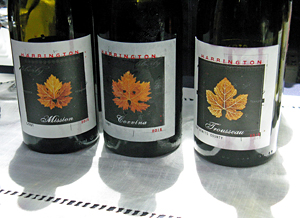 |
Bryan Harrington established his label in 2002, first making his wines in Berkeley before moving to a facility in San Francisco in 2008. He made exclusively single-vineyard Pinot Noirs for a number of years before branching out to make Nebbiolo in 2008. By 2014 he was working with over 20 different grape varieties, a few of them fairly rare in California. Bryan’s Terrane wines are made with no added sulfites. Bryan poured seven wines at the tasting – 2015 Griva Vineyard Riesling, 2015 Somers Vineyard Mission, 2015 Heirloom Ranch Corvina, 2015 Siletto Vineyard Trousseau, Terrane 2013 Nebbiolo, 2014 Sumu Kaw Vineyard “Corvo,” and 2014 Pelletiere Vineyard Lagrein. The Riesling fruit came from the Arroyo Seco area and the wine was made entirely in stainless steel. Mission was the first vitis vinifera variety introduced to California by the Spanish (it goes by different names in other countries) and this fruit came from old vines near Lodi – this was fermented partly by carbonic maceration and partly with foot-stomped whole clusters. The Corvina (one of the main grape varieties in Valpolicella and Amarone) came from another Lodi-area vineyard, while the Trousseau was sourced from San Benito County. The Nebbiolo fruit is from two Westside Paso Robles vineyards, Luna Matta and Berardo (now Pelletiere), and the wine spent about 16 months in older barrels. The “Corvo,” sourced from El Dorado County’s Sumu Kaw Vineyard, is a blend of two Portuguese varieties, Touriga Nacional and Alvarelhão.
Idlewild Wines
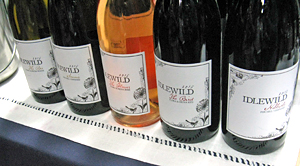 |
Sam Bilbro and his wife Jessica are the proprietors of Idlewild. The first vintage was from 2012 and the wines are made in Healdsburg. Sam grew up surrounded by grapevines and wine – his father Chris founded Marietta Cellars in 1979 – and he was one of the key people in launching the Seven % Solution tasting. I tasted five Idlewild wines at the event – 2015 “The Bee” (Moscato, Friulano, Arneis, Cortese), 2015 Arneis, 2015 “The Flower” Rosé (from Dolcetto, Nebbiolo, Barbera), 2015 “The Bird” (Dolcetto, Nebbiolo, Barbera), and 2013 Nebbiolo. Most of the fruit for these wines came from Fox Hill Vineyard near Ukiah in Mendocino County. Although last year I preferred the varietal wines to the “Flora & Fauna” blends, this year it was the opposite. The Arneis had floral and stone fruit aromas with medium acidity and a fairly round texture. I liked the Nebbiolo better, with its tar and earth scents along with bright cherry plus a hint of flowers, and good structure but not as tannic as most young Nebbiolos. “The Bee” showed its perfumey Muscat component clearly but balanced that with bright stone fruit and tropical fruit aromas, a touch of spice, and good acidity – should be a pleasant summertime wine. “The Flower” was made partly from whole-cluster pressed fruit and partly from saignée, and it displayed both citrus and strawberry fruit, herbs, and flowers on the nose, with a juicy mouthfeel and clean finish. “The Bird” was my favorite of the Idlewild wines, featuring earthy plum and black cherry fruit, spice, and a slight floral note, with a lively texture and moderate tannins.
Jolie-Laide Wines
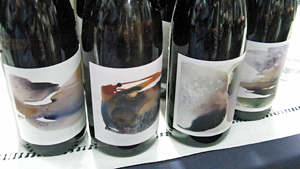 |
Scott Schultz of Jolie-Laide has worked with Pax Mahle at Wind Gap. The winery name is a French term translating literally to “pretty-ugly” but meaning unconventionally beautiful. The wines are made in Forestville in the same building where Wind Gap got started out. The label artwork changes each year, with the striking current labels from Italian artist Sabrina Garrasi. I tasted four Jolie-Laide wines this year – 2015 Rorick Heritage Vineyard Pinot Gris, 2015 Fanucchi-Wood Road Vineyard Trousseau Gris (pre-release), 2015 Barsotti Vineyard Gamay, and 2014 Rossi Ranch Grenache/Syrah (pre-release). The Pinot Gris fruit came from Matthew Rorick’s vineyard in Calaveras County, and it was kept on the skins for two days prior to pressing, then aged in neutral oak. This showed pear and citrus aromas along with hints of flowers and herbs, with a phenolic character and slight grip on the finish – an intriguing wine that should show better both with some additional bottle age and with food. The Trousseau Gris spent a bit more time on the skins, and showed stone fruit, earth, and a touch of spice on the nose, with more weight on the palate than the Pinot Gris. The Gamay, from El Dorado County, was made partly with carbonic maceration and with whole-cluster fermentation, and the wine was aged in neutral oak. This was peppery, with bright black cherry fruit, earth, and herbal/stemmy undertones, a lively mouthfeel and fine tannins – my favorite of the Jolie-Laide wines. The last wine, sourced from Sonoma Valley’s Rossi Ranch, was a blend of mostly Grenache and Syrah as well as a little Viognier and Muscat of Alexandria. The floral notes from the two white varieties were apparent but subtle, and the wine displayed both red and black fruit aromas plus earth and spice, with medium body and fairly firm tannins – still very young, this should round into form given more time in the bottle.
La Clarine Farm
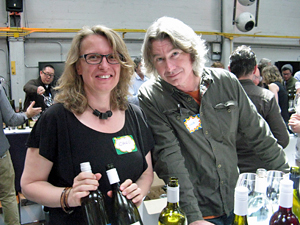 |
La Clarine’s Hank Beckmeyer and his wife Caroline Hoël established their winery in 2007. They purchase most of their fruit, but also have a small vineyard planted to Tempranillo, Syrah, Grenache, Tannat, Cabernet Sauvignon, and a tiny amount of Negroamaro next to their home and winery in the Fair Play region of El Dorado County. Both Hank and Caroline were on hand at the tasting, and they poured me four wines – 2015 Albariño (pre-release), 2014 Petit Manseng, 2015 “Jambalaia Rouge” (Mourvèdre, Marsanne, Grenache, Syrah), and 2014 “Piedi Grandi” (Nebbiolo and Mourvèdre). All of the fruit for the La Clarine wines comes from the Sierra Foothills. The Albariño came from Matthew Rorick’s vineyard and spent six months in stainless steel – although this displayed bright citrus and stony mineral notes along with hints of flowers and herbs, this seemed a little closed down at the moment but it could well develop into a standout given a bit more time (as the 2014 vintage of this wine was). The Petit Manseng was a favorite, with subtle tropical fruit notes along with a savory quality and a lively, slightly chalky texture and finish. The Mourvèdre-based “Jambalaia Rouge” blend was one of my favorites at last year’s tasting and the new vintage was a standout too – bright and savory raspberry and black cherry fruit, hints of flowers and earth, with juicy acidity on the palate and fine tannins on the finish. The “Piedi Grandi” is a 50/50 blend of Nebbiolo and Mourvèdre, and displayed aromas of plums, earth, and dried herbs, and a bolder mouthfeel with fairly big but round tannins. Another fine line-up of wines from La Clarine Farm.
|
Leo Steen Wines
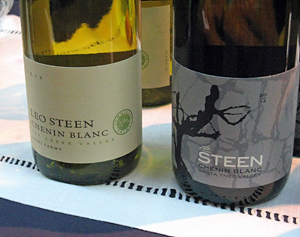 |
Owner/winemaker Leo Hansen is originally from Denmark, and launched the Leo Steen label in 2004. He specializes in Chenin Blanc – that variety seems a natural since Steen, his middle name, is also a South African term for the grape! The Chenin Blanc vines at both Saini Farms (Dry Creek Valley) and Jurassic Park Vineyard (Santa Ynez Valley) were planted in the early 1980s. I tasted three of the Leo Steen wines – 2015 Saini Farms Chenin Blanc, 2012 Jurassic Park Vineyard Chenin Blanc, and 2014 Proviser Vineyard Grenache. The Saini Farms Chenin Blanc had bright apple and herb aromas with a lively mouthfeel and finish. The Jurassic Park bottling showed another side to the grape variety – in a style meant for cellaring, and aged in concrete and oak, this had a more earthy and slightly oxidative character plus stone fruit and herbs, with a richer texture and stony mineral note on the finish. The Grenache, from a site in Dry Creek Valley, was fermented entirely with whole clusters – about 25% with carbonic maceration – and spent 16 months in neutral puncheons. This featured bright red fruit, lots of spice, and touches of earth and pepper, with medium weight on the palate and fairly big tannins – needs time to settle down but has good potential for aging. Nice wines, with the Jurassic Park Chenin Blanc being a particular standout.
Lioco Wine
Established in 2005 by wine importer Matt Licklider and sommelier Kevin O'Connor, Lioco combines their last names. Their focus is Chardonnay, Pinot Noir, and Carignan from Sonoma, Mendocino, and Santa Cruz counties. John Raytek has been the Lioco winemaker since 2011. I tasted three wines at the Lioco table – 2014 Grüner Veltliner, 2015 “Indica” Rosé (from Carignan), and 2014 “Sativa” Carignan. The Grüner Veltliner, from Alfaro Vineyard in the Santa Cruz Mountains, is Lioco’s first. Fermented in neutral oak and aged in stainless steel, this displayed apple and spice aromas with floral undertones, medium body with a smoother texture. The whole-cluster pressed “Indica” Rosé had strawberry and herb notes along with fine acidity and a crisp finish. The “Sativa” – my favorite of the three wines – was made entirely with whole clusters and showed bright black cherry and darker fruit, fresh herbs, and a touch of forest floor earthiness, with medium weight and moderate tannins.
Living Wines Collective
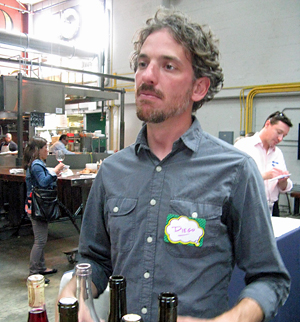 |
Living Wines Collective is made up of four friends who produce wines under three different labels. All four of them – Sam Baron, Shaunt Oungoulian, Diego Roig, and Martha Stoumen – combine for their Populis label. Martha and Diego also have a label called Elizia (formerly Ama), while Sam and Shaunt make Les Lunes. They work with organically-farmed, old-vine fruit and make their wines in Orinda, just over the hills from Oakland and Berkeley. Diego was pouring their wines, and I tried three of them – Populis 2015 “Reversée” Carignane (pre-release), Elizia 2014 Carignane, and Ama 2014 Nero d’Avola. The fruit for all three of these wines came from Mendocino County. The “Reversée” Carignane uses an interesting technique that Diego described as a “reverse saignée” – they take unfermented rosé juice and add it to a tank of whole clusters, then seal the tank. This should be a fun wine when it’s released, light, savory, and earthy, with juicy red fruit and moderate tannins. The Elizia Carignane was whole-cluster fermented and spent 42 days on the skins, then aged for 16 months – bright black cherry and spice on the nose with a more elegant texture than most Carignanes and a lively finish. The Ama Nero d’Avola was made with destemmed fruit, and featured a darker and earthier character with herbal undertones, more structure on the palate, and grippier tannins. All three were good, with the Elizia Carignane being a standout.
Matthiasson Wine
Steve Matthiasson is a highly-regarded viticulturist in addition to making wine, and he has an impressive list of clients, mainly in Napa. He and his wife Jill run the winery and produced their first commercial vintage in 2003. In addition to purchased fruit, they also have their own Napa vineyard, which includes Ribolla Gialla, Refosco, Schioppettino, Merlot, and Petit Verdot. Jill was behind the table at the tasting and she poured me three wines – 2013 White Wine (Sauvignon Blanc, Sémillon, Ribolla Gialla, Friulano), 2013 Ribolla Gialla and 2013 Refosco. The Sauvignon Blanc-based White Wine was savory and herbal, with spicy, floral, and stone fruit notes, medium-bodied with a creamy mouthfeel and lively finish – a distinctive wine. The Ribolla Gialla was fermented on the skins for 12 days, and featured higher-toned pear and citrus aromas with a slightly nutty quality, and a more structured texture on the palate. The Refosco, from the Matthiassons’ own vineyard in the Oak Knoll area, was my favorite of the three wines, featuring dark berry fruit, earth, pepper, and a slightly gamy note, along with juicy acidity and firm tannins – this should develop nicely with time in the cellar.
Nico Wines
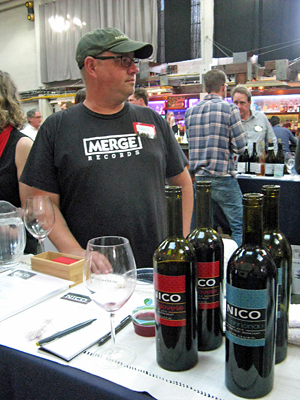 |
Nico was established in 2008 by winemaker Kevin Rogers. The name comes from his mother’s name, Nicolina, and the fact that her family was from Nicosia in Sicily. The first few Nico vintages were entirely Dolcetto, and beginning in 2012 Kevin has branched out into a number of other varieties. I tasted two wines at the Nico table, 2014 Sangiovese and 2013 “il Cannonau.” The Sangiovese was sourced from Venturi Vineyard near Calpella in Mendocino County. With bright cherry and plum fruit, earth, and spice on the nose, this had a lively texture and a somewhat grippy tannic finish – could use some time to settle down a bit. The second wine, “il Cannonau,” is 100% Grenache from Proviser Vineyard in Dry Creek Valley – the grape variety is known as Cannonau on the Italian island of Sardinia. Fermented with destemmed fruit and aged in neutral oak, this had a distinct stony mineral character along with red fruit, spice, touches of flowers and orangepeel, medium weight on the palate with good structure and fine tannins – this was a standout.
Preston Vineyards
Preston Vineyards has been in transition in recent years. Founded in the 1970s by owners Lou and Susan Preston, the winery has downsized from around 25,000-case annual production to about 8,000 cases, they’ve diversified their farmland and are now certified organic. They’ve even changed their name to Preston Farm and Winery. Matt Norelli is the Preston winemaker. They’ve been working with Rhône grape varieties longer than most in Sonoma County so it’s appropriate that they’re now a part of this event. I tasted four wines at the Preston table – 2014 Grenache Blanc, 2013 Cinsault, 2013 Carignane, and 2014 Barbera. The fruit for all of these wines came from the Preston estate vineyard. The Grenache Blanc had apple and spice aromas, with medium body and a somewhat rustic character. The Cinsault featured darker berry fruit, earth, dried herbs, and a touch of vanilla/oak, with medium weight on the palate and moderate tannins. The Carignane showed cherry, earth, and spice, with a lively texture and a bit more tannic grip on the finish. The Barbera was my favorite of the Preston wines, displaying black cherry, lots of spice, and hints of herbs and smoke, plus bright acidity and moderate tannins.
RPM Wines
RPM is a partnership of Nathan Roberts, Rajat Parr, and Duncan Meyers, whose initials created the winery name. The first RPM vintage was from 2011. The winery focuses exclusively on Gamay Noir, from the same two Placerville-area sites where Steve Edmunds has sourced his Gamay over the years – Witters and Barsotti vineyards. The 2014 Gamay Noir was poured at the Arnot-Roberts table. Made with partial carbonic maceration, this displayed aromas of black cherry and raspberry fruit, fresh herbs, and touches of spice and earth, along with a silky texture and fine tannins on the long finish. Tasty now but this has the structure to age for a few years too – the best RPM Gamay yet.
Ryme Cellars
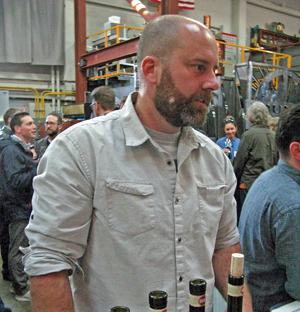 |
Ryme Cellars was founded in 2007 by Ryan and Megan Glaab – the first two letters of their first names form the winery name. They work mostly with less-common California grape varieties for Ryme, while they also make Chardonnay and Pinot under the Verse label. Ryan was on hand to pour at the event, and I tasted six of the Ryme wines – 2013 “Crackling Carignane,” 2015 “Hers” Vermentino, 2014 “His” Vermentino, 2013 Ribolla Gialla, 2014 Cabernet Franc, and 2012 Aglianico. From old vines at Testa Vineyard in Mendocino’s Redwood Valley, the “Crackling Carignane” is a sparkling wine made by the Pétillant Naturel technique, bottled at 0.5 brix and disgorged this year. This featured bright red fruit, earth, herb, and lees aromas, lightly bubbly with a clean, fresh finish – a very pleasant “pet nat.” The “Hers” and “His” versions of Vermentino, both sourced from Francis Mahoney’s Las Brisas Vineyard in Carneros, always make for a fascinating contrast. “Hers” is whole-cluster pressed, settled and racked into stainless steel and neutral oak, and bottled early. “His” is destemmed and fermented on the skins, then aged in older oak for about 10 months. The “Hers” displayed pear and stone fruit, floral and herbal notes, and a touch of wet stone on the nose, with a lively mouthfeel and finish, while “His” showed the more phenolic skin-fermented character with less upfront fruit and more earth and dried herb aromas and a noticeable tannic grip on the finish. The Ribolla was fermented and left on the skins for six months – this had lots of spice and earth on the nose, with apple and pear fruit in the background and a moderately tannic finish. The Cabernet Franc, from Alegría Vineyard in Russian River Valley, was fermented entirely with whole clusters and partial carbonic maceration, and showed somewhat stemmy aromas along with other herbal, floral, and red fruit notes – this seemed a bit closed down but has the potential to develop nicely with some time in the cellar. The final wine as the Aglianico, from Luna Matta Vineyard on the Westside of Paso Robles – dark, spicy, earthy, and savory, with full body and huge tannins, another wine that will need bottle age. My favorites of this strong overall line-up were the “Crackling Carignane” and “Hers” Vermentino.
Ser
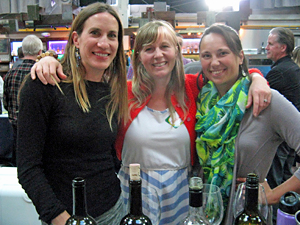 |
| Nicole Walsh (left) and crew |
Ser owner/winemaker Nicole Walsh launched her winery with the 2012 vintage. She also holds several positions at Bonny Doon Vineyard, including vineyard manager and associate winemaker. Her wines use native yeast fermentations and she makes no additions during the winemaking process. In addition to the wines tasted at this event, Ser currently produces Chardonnay, Pinot Noir, Syrah, Cabernet Franc Rosé, and sparkling Riesling. Nicole poured me three wines – 2015 Dry Orange Muscat, 2015 Rosé of Nebbiolo, and 2014 Cabernet Pfeffer. The first two wines came from Lake County fruit, while the third one was sourced from Cienega Valley in San Benito County. I’d only tried a few California Orange Muscats before, and they were all sweeter wines, so this one was a different take on the variety for me. With lots of orangepeel, floral, and spice aromas, this had good acidity and a clean finish, quite distinctive. The Rosé was destemmed prior to pressing, and featured both red fruit and stone fruit on the nose, earth, and dried herbs, along with more structure and bite than most rosé wines – an intriguing wine that was my favorite of the Ser bottlings I tasted. The Cabernet Pfeffer was aged in 50% new French oak, which showed in the aromatics, along with plum, pepper, and spice, with a bigger structure and fairly grippy tannic finish.
The Scholium Project
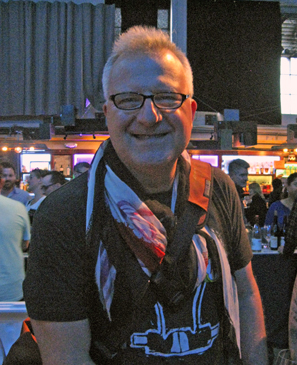 |
Philosophy professor-turned-winemaker Abe Schoener is the man behind The Scholium Project. He first made wine with Napa’s John Kongsgaard in 1998 and launched his own label in 2000. The wines are known for being some the most daring and experimental bottlings in California – few producers are farther “out there”. The wines are made at the Tenbrink facility in Fairfield. I tasted four wines – 2015 “Blowout” (sparkling wine from Loureiro, Grüner Veltliner, and Verdelho), 2015 “VLV” Verdelho, 2015 “FTP” Pinot Gris, and 2014 “Steverjan” Pinot Gris. The fruit for the first three of these wines came from the Lodi area. I enjoyed the 2014 “Blowout” last year, and this one may have been even better. Made by force carbonation – “Méthode Futuriste” – the fruit for this wine was harvested in July and August and bottled by November. Lightly bubbly with pear fruit, earth, and touches of spice and wet stone, it’s more complex than last year’s version but still ready to drink now. The “VLV” Verdelho was barrel-fermented, and showed higher-toned stone fruit aromas, herbs, and medium acidity, with a fairly rich and somewhat oily texture. The “FTP” Pinot Gris fruit came from Tegan Passalacqua's Kirshenmann Vineyard, with 15% of the fruit fermented on the skins – with spicy stone fruit and earth notes plus phenolic richness and fine acidity, this has the structure to age for a few years. The “Steverjan” Pinot Gris was sourced from Rocky Hill Vineyard in the Sonoma Mountain appellation, and was fermented with whole clusters, giving it a bronze color. Featuring savory herbal aromas, tingly acidity, and a slightly chalky texture, this was distinctive and delicious, along with the “Blowout” my favorite of The Scholium Project wines.
Tatomer
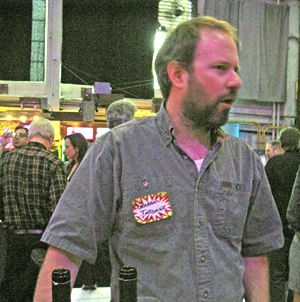 |
Graham Tatomer founded his eponymous label in 2008 with the goal of producing dry Riesling from cool-climate vineyard sites in California’s Central Coast region. He’s added Grüner Veltliner, Sylvaner, and Pinot Noir to his wine line-up in recent years. Graham was behind the table at the tasting and he poured me three of his wines – 2015 “Meeresboden” Grüner Veltliner, 2014 “Vandenberg” Riesling, and 2014 Kick-on Ranch Riesling. The “Meeresboden” Grüner Veltliner is sourced from two vineyards in Santa Barbara County – this displayed bright green apple, citrus, floral, and spice aromas with zippy acidity and a saline note on the crisp finish, very nice. The “Vandenberg” Riesling comes from Kick-on Ranch in the Los Alamos Valley in Santa Barbara county, and showed bright citrus and stone fruit, some petrol notes as well as a touch of honey (from some botrytis in the grape clusters), with medium body, vibrant acidity, and a clean finish. Any botrytis was sorted out for the Kick-on Ranch Riesling, which also underwent some skin contact and was aged in neutral oak. This had less of a petrol component than the “Vandenberg” bottling and more herb and earth on the nose, plus the expected phenolic richness from skin contact along with fine acidity and a slightly chalky finish – this has the potential to age nicely. All three were impressive wines, with the first two being particular favorites.
Two Shepherds Vineyards
As he usually is, Two Shepherds owner/winemaker William Allen was behind his winery table. The label focuses mainly on wines made from Rhône grape varieties. The wines are made in Sonoma County, and the first commercial vintage was in 2010. William poured six wines for me – 2013 “A Tribute to Saralee Kunde” Grenache Blanc, 2013 “Centime,” 2014 Trousseau Gris, 2014 Carignan, 2013 Grenache, and 2012 “Pastoral Rouge” (45% Grenache, 25% Syrah, 30% Mourvèdre). The Grenache Blanc was from Catie’s Corner Vineyard in Russian River Valley, which was owned by the late Saralee Kunde, one of the area’s best-known growers. Aromas of apple, herbs, and touches of petrol and flowers, this had lively acidity with medium-light body and a clean finish. The “Centime” is mainly Grenache Blanc, plus a little Marsanne and Roussanne, sourced from Santa Ynez Valley and El Dorado County, skin-fermented and pressed when dry. Pear and stone fruit notes along with petrol, earth, and spice, showing a slightly chalky texture and finish, quite intriguing and has the potential to develop further in the bottle. The Trousseau Gris came from Fanucchi Vineyard in Russian River Valley, and had five days of skin contact, showing citrus and earth aromas with medium weight and a slight grip on the finish. The Carignan, from Trimble Vineyard in Mendocino, was fermented with 35% whole clusters, and had aromas of fresh black cherry, herbs, and earth, with medium body and a chalky finish. The Grenache and “Pastoral Rouge” both came from Russian River Valley fruit, and shared somewhat similar character – spicy, mostly red-fruited, with moderately grippy tannic finishes, though the Grenache added more tea leaf notes while the “Pastoral Rouge” had a bigger earth component plus a slightly tangy finish. Overall I preferred the whites to the reds, with the two renditions of Grenache Blanc being favorites.
Unti Vineyards
The vineyard was first planted in 1990 and the Unti label was launched in 1997. The winery has long been known for Rhône and Italian grape varieties, as well as Zinfandel. Fruit for all of the Unti wines at the tasting came from their estate vineyard in the heart of Dry Creek Valley. Mick Unti was on hand at the event. Unfortunately I ran out of time before I could taste at the Unti table, but I did get a brief report on their whites and rosé from my friend Wes Barton – he tried their 2015 Grenache Blanc, 2015 Fiano, and 2015 Rosé. He mentioned that all three of these were pleasant and showed good varietal character, and he noted that the Grenache Blanc and particularly the Fiano were very good. Wes didn’t get back to their table to taste the reds, though the Unti Montepulciano has been a favorite of mine in the past.
Westwood Wines
Originally founded in the 1980s, the winery has undergone several ownership changes over the years. Their estate Annadel Gap Vineyard, in northern Sonoma Valley, was planted in 2001 to Viognier, Roussanne, Pinot Noir, Grenache, Mourvèdre, Syrah, and Counoise. Ben Cane, formerly with Twomey Cellars, is the winemaker and David Ramey consults. The inaugural releases of the re-launched Westwood label came from the 2014 vintage. I tasted five wines – 2014 “Elevation” (53% Grenache, 29% Mourvèdre, 12% Syrah, 6% Counoise), 2014 Estate Counoise, 2014 Estate Grenache, 2014 Estate Mourvèdre, and 2014 “Legend” (45% Tannat, 44% Syrah, 11% Counoise). The wines were fermented with up to 50% whole clusters and most were aged in 30-45% new oak. The “Elevation” was red-fruited with spice and vanilla/oak undertones, finishing with moderate tannins. The Counoise and Grenache also showed a distinct sweet oak component on the nose, with more herbal and floral notes for the Counoise and spice for the more tannic Grenache. The Mourvèdre was my favorite of the Westwood wines, with peppery, earthy, and herbal aromas along with ripe dark berry fruit, with a more structured mouthfeel and firm tannic finish. The “Legend” was aged in 60% new oak, and displayed ripe black fruits, spice, and touches of mocha and sweet oak, with a richer texture and broad tannins.
Wind Gap Wines
Wind Gap, founded in 2006, is the label of Pax and Pam Mahle. A few years ago the winery moved into The Barlow, a complex of new and renovated buildings on the eastern edge of downtown Sebastopol. Pax makes wines under two additional labels as well, Agharta and Pax Mahle Wines. Pax poured three wines for me – 2015 Trousseau Gris, Pax 2015 “Buddha’s Dharma” Chenin Blanc (pre-release), and 2015 “Soif” (Valdiguié, Petite Sirah, Negroamaro, Dolcetto, Zinfandel, Mourvèdre). Sourced from Russian River Valley’s Fanucchi-Wood Road Vineyard, Wind Gap’s Trousseau Gris was fermented mostly in concrete eggs and aged in stainless steel and neutral oak. This showed citrus and stone fruit aromas with a bit more texture and weight than the previous vintage. The Pax “Buddha’s Dharma” Chenin Blanc from Mendocino County – darn, I wish I’d taken better notes on this one other to jot down that it had pear aromas and that I liked it! Finishing up was Wind Gap’s North Coast “Soif” blend, made by carbonic maceration in a concrete tank – with black cherry and plum fruit, earth, spice, hints of flowers and fresh herbs, plus a lively mouthfeel and milder tannins, this should be a fine choice for near-term drinking.
|


